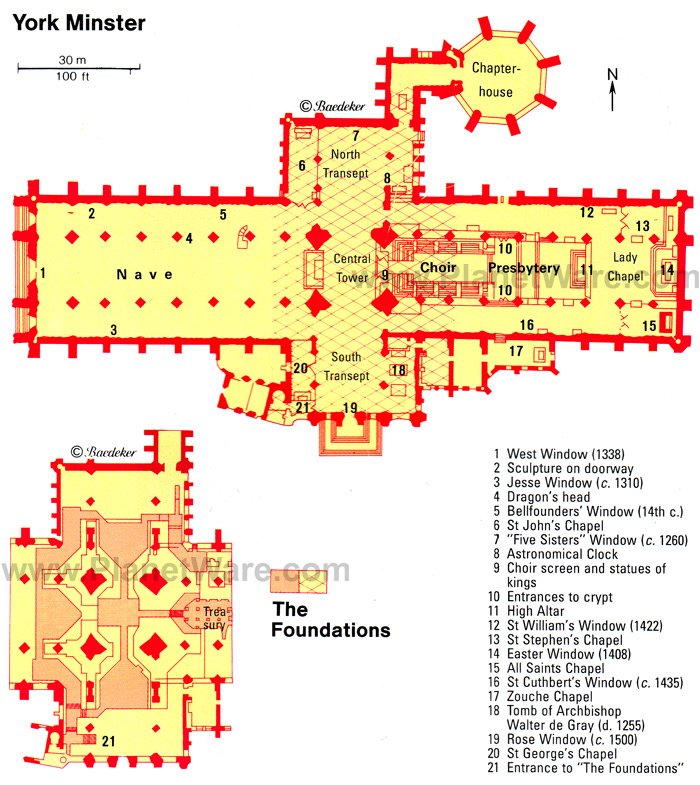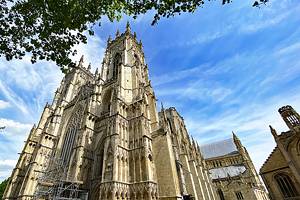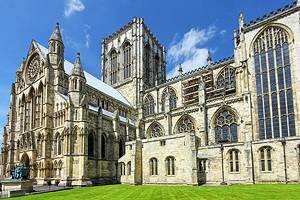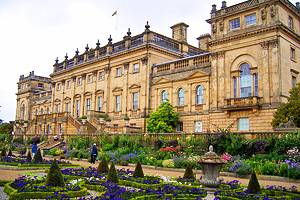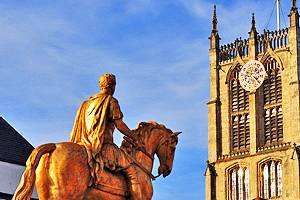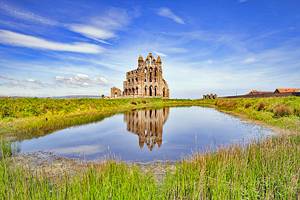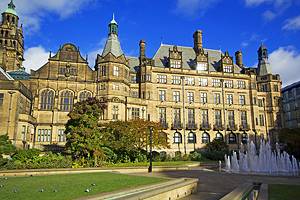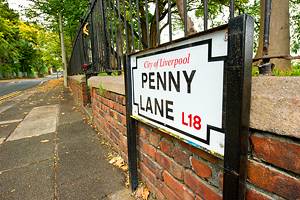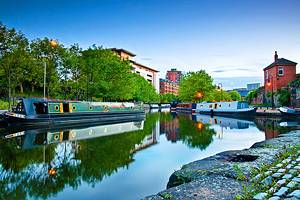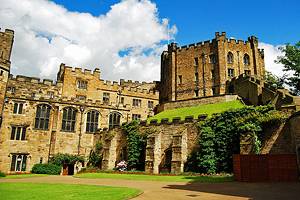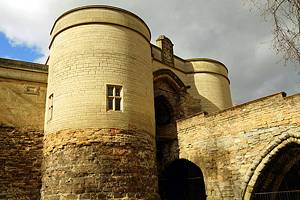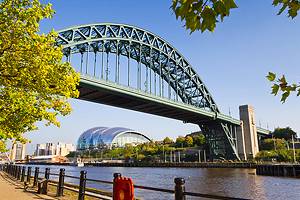Exploring York Minster: A Visitor's Guide
Dedicated to St. Peter, one of the 12 Apostles, imposing York Minster stands testament to the monks who converted the locals to Christianity in the 3rd and 4th centuries. So important was York Minster in the Christian faith's early years - and so great its reputation - that its bishops were invited to participate in the council at Arles in AD 314.

After this, little was heard about it until AD 627, when the oldest documented (wooden) church was built here for the baptism of King Edwin of Northumbria. Succeeding Saxon and Norman constructions were destroyed, and the cathedral was rebuilt in its present Gothic style in the 13th century.
You'll learn more about this remarkable structure in our handy visitor's guide to exploring York Minster.
On This Page:
- First Impressions: The Side Aisle Windows
- The Choir Aisle and the North Transept
- The Choir
- The Organ
- Tombs and Tales from the Crypt
- The Chapterhouse
- The Close
- Treasures of the Undercroft: Revealing York Minster
- Stairway to Heaven: Climbing the Central Tower
- Touring York Minster
- Tips and Tactics: How to Make the Most of Your Visit to York Minster
- Getting to York Minster
- What's Nearby?
First Impressions: The Side Aisle Windows

First impressions are everything, and even the humble aisles you see upon entering York Minster impress, with their interesting decorative features. In the north aisle on the left-hand side as you enter, the chapel door is notable for its 14th-century sculptures.
A little farther along is the Pilgrimage Window. Dating from about 1312, it rests above a stunning dragon's head, and depicts Peter surrounded by pilgrims. It also includes many other unusual details, one of the most interesting being the funeral of a monkey.
Next to this is the radiant 14th-century Bellfounders' Window with its relevant motifs. The Jesse Window - dating from about 1310 - is also remarkable, and depicts scenes including David and Solomon.
The Choir Aisle and the North Transept

The triple-naved Choir Aisle was built in the English early-Gothic style between 1220 and 1280. At the back wall of the North Transept, you'll see five narrow lancet windows dating from about 1260. They're known as the Five Sisters Window after a term coined by Charles Dickens.
The Crossing, with its 15th-century vaulted tower contains the Rood-screen. This masterpiece of late Gothic sculpture contains statues of 15 English kings, starting with William I on the left and finishing with Henry VI.
The Choir

The cathedral's Norman Choir was rebuilt in the late 14th century and was later damaged by a fire in 1829 that destroyed the roof and woodwork (including the choir stalls). Copies of the originals have replaced all that was destroyed.
St. William's Window (1422) in the South Gallery depicts scenes from the life of St. William, whose shrine in the sacristy was worshipped in the Middle Ages. St Cuthbert's Window (dating from about 1435) in the North Gallery portrays events in the life of this saint, who was consecrated as Archbishop in AD 685 in the former Saxon minster.
Behind the Choir is the Lady Chapel. This important chapel is famous for its magnificent East Window, which dates from about 1408 and is reputed to be the world's largest medieval stained-glass window. In the South Transept is the marvelous Rose Window dating from around 1500 and commemorating the ending of the War of the Roses, fought between the Houses of Lancaster and York for the throne.
The Organ

Standing tall at the far end of the Choir, and notable for its tall, spire-like façade, York Minster's Grand Organ is indeed a thing of beauty. Built in the 1830s, this spectacular, ornate instrument was actually removed in 2018 and completely renovated, only returning to action in the spring of 2021.
Boasting an impressive 5,400 beautifully decorated pipes - most of them original - the now fully-restored organ has a very unique sound, which can once again be heard when the instrument is put through its paces. In addition to supporting the cathedral choir for regular weekday and Sunday services, you can also hear it in action during seasonal services at Easter and Christmas. For a real treat, check the cathedral's official website for news of special concerts and organ recitals.
Tombs and Tales from the Crypt

The minster's 12th-century Norman Crypt is entered from the Presbytery. It's here you'll find the remains of the 11th-century Apse of the earlier cathedral, as well as parts of the 14th-century Eastern Crypt.
The Crypt's most valuable contents include the York Virgin (12th-century Madonna); the Doomstone (purgatory relief, late 12th century); the 15th-century font used for the baptism of King Edwin by Bishop Paulinus in AD 627; and the shrine of St. William of York (Archbishop, d. 1154), which was brought here in 1972.
The Chapterhouse
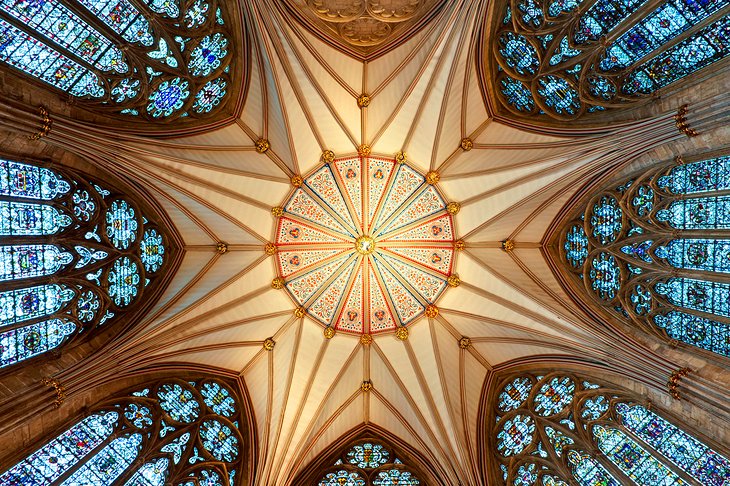
The Vestibule of the Chapterhouse is reached from the North Transept. On entering this part of the cathedral, visitors will immediately notice a window dating from about 1300 that depicts kings and queens, and the richly decorated capitals. The flaying of St. Bartholomew can be seen on a capital to the right of the 13th-century door with interlaced decoration leading to the octagonal Chapterhouse (1260-1285).
The painted, wooden vaulted roof is self-supporting and was renewed first in 1798 and again in 1976. The fine stall-canopies are impressive, as are the tracery windows, the glass of which dates from the 13th century.
The Close

Among the many interesting buildings found in York Minster Close are the 15th-century, half-timbered St. William's College, with its medieval chambers. Also worth seeing are the 17th-century Treasurer's House, containing numerous antiques, and the Minster Library, housed in a 12th-century chapel and home to more than 120,000 books and manuscripts.
On the south side of the minster is the church of St. Michael-le-Belfrey. Rebuilt in 1536, it has interesting stained-glass windows. A 4th-century Roman column standing behind it commemorates the day Constantine was proclaimed Emperor of Rome in York in AD 306.
Treasures of the Undercroft: Revealing York Minster

Located in the crypt underneath York Minster, the fascinating Treasures of the Undercroft museum is well worth exploring. Here, you'll find numerous interactive galleries portraying the building's colorful history, from its Roman roots to today.
Displays include more than 2,000 years of remarkable artifacts found nearby in the 19th century during work to shore up the cathedral's foundations. These fascinating displays provide an insight into the cathedral's important role over the centuries.
Stairway to Heaven: Climbing the Central Tower

York Minster's spectacular medieval Central Tower is the highest point in the city. Climbing it is a must-do, though it does involve a climb of 230 feet up 275 steps, so isn't for the faint of heart.
Along the way, you'll get a close-up view of some of the cathedral's most interesting decorative features, including its pinnacles and gargoyles. Once outside, all that hard work will be rewarded with superb views of York's historic city center.
Touring York Minster
York Minster offers a number of excellent guided tours (included with admission) highlighting the building's main features and history, as well as some of its lesser-known secrets. Options include tours of the crypt and highlights of the cathedral's amazing stained-glass windows.
If you're traveling with youngsters, ask for one of the cathedral's Little Explorer Backpacks when purchasing your tickets. These fun (and free) backpacks include a host of neat tools for youngsters to use as they explore, including a flashlight, binoculars, a compass and map, magnifying glass, and pencil crayons and paper to record their findings.
Tips and Tactics: How to Make the Most of Your Visit to York Minster
- Closures: York Minster is very much a working building, and while sightseers are permitted, there are occasions when closures are necessary. To ensure such eventualities don't interfere with your visit, check the cathedral's What's On page before arrival.
- Events: Lectures, workshops, and courses are often available to the general public and visitors, along with musical performances and other special events. To learn more, visit the cathedral's What's On page.
- Food: While York Minster has no food outlets of its own, it's located in a vibrant pedestrian area with countless excellent dining options, from fast fresh food to fine dining.
- Shopping: Two on-site shops serve visitors: the Minster Gift Shop (within the Minster) and York Minster Gifts and No.10 (situated in Minster Gates). Most items available here are also available from their online shop.
- Services: Weekday and weekend services - usually accompanied by the York Minster organ - are open to the public.
Getting to York Minster
- By Train: York has fast, direct rail links from London, Edinburgh, and Manchester (approximately two hours travel time) and is just a 10-minute walk from York Rail Station. For details, including occasional 2-for-1 ticket offers, visit www.nationalrail.co.uk.
- By Road: York is centrally located and easily accessible from all parts of the country by an excellent road network.
- Parking: The City of York operates a network of perimeter parking lots with buses connecting to the heart of the city.
Address
- Deangate, York
- www.yorkminster.org
What's Nearby?
York Minster sits amid some of the very best sightseeing attractions in England and is a place where you'll want to spend more than a day, if possible. One of the best ways to experience this remarkable city is to walk along its circuit of medieval city walls, nearly three miles long and offering marvelous views. Also, spend time walking along the River Ouse or, better still, take a river cruise.
Other York tourist attractions within an easy walk are York Castle and its excellent museum; the National Railway Museum, with its impressive collection of steam engines; and the city's numerous historic guildhalls. Then, of course, there are the many ancient winding streets, in particular the famous Shambles, a narrow, 14th-century thoroughfare with lovely overhanging timber-framed buildings.
York was also once a Viking stronghold, and the Jorvik Viking Centre is a great place to learn more about this fascinating period in the city's history.
More Related Articles on PlanetWare.com
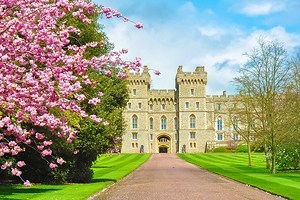
Top Weekend Breaks: Thanks to its relatively small size - and excellent bus and rail networks - England boasts plenty of delightful weekend breaks and getaways. Favorites include London, popular for its many Royal residences, none so-spectacular as Buckingham Palace, and beautiful Bath, famous for its well preserved Georgian and Roman-era architecture.

Best Romantic Breaks: Couples seeking a romantic weekend break are spoiled for choice in the UK. Top destinations for couples looking for quality time together include the city of Edinburgh in Scotland, popular for its spectacular castle and the romantic Royal Mile, and the university town of Cambridge, where couples will want to explore the historic canals aboard a classic punt. Active couples seeking a superlative hiking experience should head to Loch Lomond, considered one of Scotland's prettiest lakes.
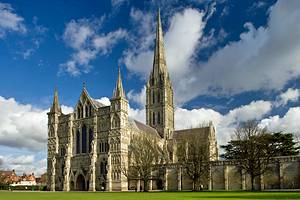
Top UK Vacation Ideas: Among the best places to visit in the UK for a great family vacation, Salisbury is famous not only for its magnificent medieval cathedral, but the even older (much older!) Stonehenge, one of the country's most recognizable ancient landmarks. Those wanting to see one of the UK's most important castles should head to Windsor, home to the royal residence of Windsor Castle, or Warwick, home to both a stunning castle and a well-preserved old city center dating from the Middle Ages.
